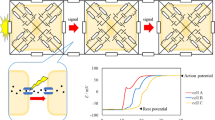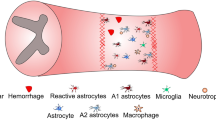Abstract
By means of a condenser-discharge electric shock paradigm, “dark” granule neurones were momentarily produced in a sporadic distribution among normal ones in the otherwise undamaged (non-necrotic, non-excitotoxic, non-inflammatory or non-contused) hippocampal dentate gyri of the rat brain. In the electron microscope, the ultrastructural elements of the affected neurones remained undamaged but turned markedly electron-dense and the distances between them became strikingly reduced (compaction). A proportion of such neurones recovered in 1 day while others died. During the first week of survival, the dead “dark” granule neurones retained the compacted and electron-dense ultrastructure, but underwent cytoplasmic convolution and fragmentation. The fragments were enclosed by membranes and separated from each other and from the intact neuropil by astrocytic processes containing an excess of glycogen particles. Neither proliferation of microglial cells nor infiltration of haematogenous macrophages was observed. A few fragments were taken over by resting microglial cells, while the majority was engulfed by astrocytes. The latter transported the engulfed fragments, either unchanged or digested to various degrees, to capillaries, arterioles and venules. Thereafter, the astrocyte-engulfed neuronal fragments, as well as their partly or completely digested remnants, were either transferred to phagocytotic pericytes or discharged into vascular lumina.
Similar content being viewed by others
References
AUER, R., Kalimo, N. H., Olsson, Y. & SIESJÓ, B. K. (1985) The temporal evolution of hypoglycemic brain damage I. Light- and electron-microscopic findings in the rat cerebral cortex. Acta Neuropathologica (Berlin) 67, 13–24.
AL-ALI, S. Y. & AL-HUSSAIN, S. M. (1996) An ultrastructural study of the phagocytotic activity of astrocytes in adult rat brain. Journal of Anatomy 188, 257–262.
ALDSKOGIUS, H., LIU, L. & SVENSSON, M. (1999) Glial response to synaptic damage and plasticity. Journal of Neuroscience Research 58, 33–41.
BECHMANN, I. & NITSCH, R. (1997) Astrocytes and microglial cells incorporate degenerating fibers following entorhinal lesion: A light, confocal and electron-microscopical study using a phagocytosis-dependent labelling technique. Glia 20, 145–154.
BERNSTEIN, J. J., GETZ, R., JEFFERSON, M. & KELEMEN, M. (1985) Astrocytes secrete basal lamina after hemisection of rat spinal cord. Brain Research 327, 135–141.
CAMMERMEYER, J. (1961) The importance of avoiding “dark” neurons in experimental neuropathology. Acta Neuropathologica (Berlin) 1, 245–270.
CHENG, H. W., JIANG, T., BROWN, S. A., PASINETTI, G. M., FINCH, C. E. & MCNEILL, T. H. (1994) Response of striatal astrocytes to neuronal deafferentation: An immunocytochemical and ultrastructural study. Neuroscience 62, 425–439.
CSORDÁS, A., MÁZLÁ, M. & GALLYAS, F. (2003) Recovery versus death of “dark” (compacted) neurons in non-impaired parenchymal environment. Light and electron-microscopic observations. Acta Neuropathologica (Berlin) 106, 37–49.
DUCHEN, L. W. (1992) General pathology of neurons and neuroglia. In Greenfield’s Neuropathology, 5th edition. (edited by ADAMS, J. H. & DUCHEN, L. W.) p. 39. London: Arnold.
GALLYAS, F., ZOLTAY, G., HORVÁTH, Z., DÁVID, K. & KELLÉNYI, L. (1993) An immediate morphopathologic response of neurons to electroshock; a reliable model for producing “dark” neurons in experimental neuropathology. Neurobiology 1, 133–146.
GALLYAS, F., FARKAS, O. & MÁzlÓ, M. (2004) Gel-to-gel phase transition may occur in mammalian cells: Mechanism of formation of “dark” (compacted) neurons. Biology of the Cell 96, 313–324.
GALLYAS, F., CSORDÁS, A., SCHWARCZ, A. & MÁzlÓ M. (2005) “dark” (compacted) neurons may not die through the necrotic pathway. Experimental Brain Research 160, 477–486.
GEHRMANN, J., BONNEKOH, P., MIYAZAWA, T., OSCHLIES, U., DUX, E., HOSSMANN, K.-A. & KREUTZBERG, G. W. (1992) The microglial reaction in the rat hippocampus following global ischemia: Immuno-electron microscopy. Acta Neuropathologica (Berlin) 84, 588–595.
GRIFFITHS, I. R., MCCULLOCH, M. & CRAWFORD, R. A. (1978) Ultrastructural Appearances of the spinal microvasculature between 12 h and 5 days after impact injury. Acta Neuropathologica (Berlin) 43, 205–211.
HOLTZER, C. A. J., MARANI, E., DE PRIESTER, W. & THOMEER, R. T. W. M. (1998) The process of decompaction and myelin removal after C7 ventral root avulsion in the cat. Archives of Physiology and Biochemistry 106, 116–127.
KIDA, S., STEWART, P. V., ZHANG, E.-T. & WELLER, R. O. (1993) Perivascular cells act as scavengers in the cerebral perivascular space and remain distinct from pericytes, microglia and macrophages. Acta Neuropathologica (Berlin) 85, 646–652.
KUSAKA, H., HIRANO, A., BORNSTEIN, M. B. & RAINE, C. S. (1985) Basal lamina formation by astrocytes in organotypic cultures of mouse spinal cord tissue. Journal of Neuropathology and Experimental Neurology 44, 295–303.
LIPOSITS, Z. S., KALLÓ, I., HRABOVSZKY, E. & GALLYAS, F. (1997) Ultrastructural pathology of degenerating “dark” granule cells in the hippocampal dentate gyrus of adrenalectomized rats. Acta Biologica Hungarica 48, 173–187.
MAGNUS, T., CHAN, A., LINKER, R. A., TOYKA, K. V. & GOLD, R. (2002) Astrocytes are less efficient in the removal of apoptotic lymphocytes than microglial cells: Implication for the role of glial cells in the inflamed central nervous system. Journal of Neuropathology and Experimental Neurology 61, 760–766.
PENFIELD, W. (1925) Microglia and the process of phagocytosis in gliomas. American Journal of Pathology 1, 77–97.
SLOVITER, R. S., DEAN, E. & NEUBORT, S. (1993) Electron-microscopic analysis of adrenalectomy-induced hippocampal granule cell degeneration in the rat: Apoptosis in the adult central nervous system. Journal of Comparative Neurology 330, 337–351.
SUZUKI, M. & CHOI, B. H. (1990) The behaviour of the extracellular matrix and the basal lamina during the repair of cryogenic injury in the adult rat cerebral cortex. Acta Neuropathologica (Berlin) 80, 335–361.
THOMAS, W. E. (1999) Brain macrophages: On the role of pericytes and perivascular cells. Brain Research Review 31, 42–57.
TÓTH, P. & LÁZÁR, G. Y. (2002) Brain phagocytes may empty tissue debris into capillaries. Journal of Neurocytology 30, 717–726.
Author information
Authors and Affiliations
Corresponding author
Rights and permissions
About this article
Cite this article
Mázló, M., Gasz, B., Szigeti, A. et al. Debris of “dark” (compacted) neurones are removed from an otherwise undamaged environment mainly by astrocytes via blood vessels. J Neurocytol 33, 557–567 (2004). https://doi.org/10.1007/s11068-004-0517-5
Received:
Revised:
Accepted:
Issue Date:
DOI: https://doi.org/10.1007/s11068-004-0517-5




